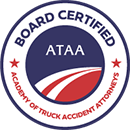How Many Hours Can a Truck Driver Drive?
Trying to do anything without enough sleep is like fighting a losing battle. You’re tired, clumsy, distracted, irritable, and just not up to your usual standards of capability.
A task as seemingly simple as driving a car is a lot more challenging when you’re sleep deprived. Imagine being exhausted and needing to drive—for 11 hours. And now imagine that your car is 30 times larger than its normal size—and filled with hazardous materials. That’s the situation many truck drivers face every day on the job.
How many hours can a truck driver drive without taking a break? Federal laws allow drivers a maximum of 11 straight driving hours, as long as they take a 30-minute break after 8 hours.
FMCSA Hours of Service (HOS) Rules for Commercial Truck Drivers
The Federal Motor Carrier Safety Administration (FMCSA) establishes the laws that drivers of commercial motor vehicles (CMVs) must follow.
One of the most important sets of laws is referred to as hours of service (HOS) rules. These laws limit the amount of time a truck driver can drive on a shift. There are two sets of HOS laws: one for drivers of cargo-carrying vehicles and one for drivers of passenger-carrying vehicles.
Below is a summary of how many hours a truck driver can legally drive.
HOS Rules for Drivers Carrying Cargo Only
CMV operators driving cargo-carrying vehicles must adhere to the following federal HOS rules. These laws usually apply to trucks classified as semi-trucks, tractor-trailers, 18-wheelers, tanker trucks, and big rigs.
- A maximum of 11 hours of driving after 10 consecutive off-duty hours
- After 10 consecutive off-duty hours, no driving is allowed beyond the 14th consecutive hour after coming on duty
- A mandatory 30-minute break after driving for a period of 8 cumulative hours without rest
- May not drive after 60 hours on duty in 7 consecutive days, or after 70 hours on duty in 8 consecutive days
- A 7- or 8-day period can restart only after taking 34 or more consecutive hours off duty
Cargo-carrying CMV operators are allowed a few exceptions to these HOS rules. If there are adverse weather conditions that prevent normal driving, truckers are allowed to extend the 11-hour maximum driving limit and the 14-hour driving window by 2 hours at the most.
Additionally, short-haul drivers (those operating within a 150 air-mile radius of their reporting location) are also exempt from the HOS rules that apply to long-haul drivers. CMV operators who are considered short-haul truckers must finish their shift and return to their normal reporting location within 14 consecutive hours.
HOS Rules for Drivers Carrying Passengers
CMV operators driving passenger-carrying vehicles must follow a different set of federal HOS rules. These laws generally apply to charter and transit bus and commercial van drivers.
- A maximum of 10 driving hours after 8 consecutive off-duty hours
- No driving after 15 hours on duty, following 8 consecutive off-duty hours
- May not drive after 60 hours on duty in 7 consecutive days, or after 70 hours on duty in 8 consecutive days
Similar exceptions apply to drivers facing adverse weather conditions or who only operate within a 150-mile radius of their normal work reporting base.
Are Truck Driver Hours of Service (HOS) Violations Common?
Driving for 11 hours may seem like a long time to be on the road. But ground-based transportation is a multi-billion-dollar industry that makes its profits by moving products and materials as quickly as possible.
Trucking companies operate on tight deadlines, and many drivers are forced (or encouraged) to get the job done as fast as they can—even if it means breaking a law.
Despite requirements for drivers to keep track of their driving and working hours through electronic logging device (ELD) equipment, many drivers and companies still bend the rules on a regular basis.
Some of the most common ways truckers and motor carriers break federal HOS regulations are by:
- Exceeding driving limits
- Not taking breaks
- Restarting a driving period without meeting the requirements for days or hours off duty
- Keeping false records of duty
- Manually changing logs to hide violations
When truckers drive more than they should, it creates a highly precarious situation for drivers and other motorists.
Driver fatigue is dangerous. While it’s difficult to nail down exactly how many crashes are caused by sleep-deprived truck drivers, estimates put the number of collisions caused by trucker fatigue somewhere between 13% and 40%.
The Serious Dangers of Driver Fatigue
The National Institutes of Health (NIH) points to inadequate sleep as a cause of “serious car crash injuries and death” and “human mistakes linked to tragic accidents.”
Sleep deficiency has been linked through data-based research to multiple negative effects, including:
- Physical and mental health issues
- Increased risk of injury
- Loss of productivity
- Diminished driving and social functioning
- Lowered ability to learn, focus, and react
- Feelings of worry, anxiety, and frustration
- Higher chance of falls, mistakes, and accidents
- Increased likelihood of death
Long-Term Health Risks of Sleep Deprivation
The short-term risks associated with lack of sleep are not the only health hazards long-haul truckers face. A lifestyle of sleep deprivation, erratic sleeping and waking hours, and poor-quality sleep can have a number of detrimental health and wellness impacts.
Documented adverse health outcomes associated with poor sleep habits include:
- Heart disease
- Obesity
- Lowered immune function
- More frequent illness
- High blood pressure
- Diabetes
- Kidney disease
- Depression
- Increased risk of stroke
One other dangerous risk associated with trucker fatigue is substance abuse.
Substance abuse disorders are a major concern in the trucking industry. Facing the pressures of the job and the loneliness and isolation of the road, many drivers turn to mood-altering drugs, especially stimulants that promote alertness and keep users awake for longer hours.
A 2019 survey on truck driver drug use saw a staggering 27.6% of responding truck drivers admit to the use of controlled substances on the job, with amphetamines and cocaine ranking among the most frequently abused.
When Dangerous Drivers Cause Serious Accidents
All the factors we’ve discussed above about HOS violations, driver fatigue, compromised trucker health, and behind-the-wheel substance abuse are not rare or isolated problems. There are serious issues that run rampant in the long-haul commercial trucking industry.
Many motor carriers create company cultures that foster these high-risk practices. These are environments that put truckers lives at risk and, by extension, the lives of those who share the road with them.
If a CMV trucker caused a crash because they were exhausted, fatigued, overworked, intoxicated, or physically unfit, they (or the company that employed them) must be held liable. Collisions caused by these factors should never happen in the first place. And it’s our job to do everything we can to make sure they never happen again.
If you were injured in a trucking accident, we are the law group best equipped to represent you. Trucking Injury Law Group only handles truck crash cases. Our Las Vegas trucking accident lawyers are devoted to truck accident survivors’ rights. We’ve worked conscientiously to make ourselves the best legal advocates we can be for you.
If you were injured or a family member lost their life in a preventable CMV crash, please contact us for a free case consultation.






